Supple Software Company, an S Corporation founded and owned by Ralph and Mabel Smith in 1993, sells three software products that have impressive market share. Ralph and Mabel aim to increase sales and double them by 2000. They also plan to achieve commensurate gross margin and net profit increases. Their goal is to have one employee for every $250,000 in revenue. With their flagship product, Product X, they aim to maintain a 30% market share as measured by PC Data. They believe market power, customer satisfaction, and the right management team are key to success.
Supple operates in a $3.8 billion market with a projected 20% growth rate over the next three years. They target four customer segments: home offices, small offices, professionals, and academics. These markets are growing at rates of 2%, 5%, 8%, and 0% respectively, with potential customer bases of 22,000, 15,000, 10,000, and 12,000. The US market has experienced 22% growth in the past three years, but the international market is projected to grow at 40%.
Supple Software currently offers three products. Product X is the second-leading Windows task X software and the quality leader, combining an easy-to-use interface with a powerful business analysis model. Product Y is a standalone task Y application for Windows, while Product Z is a creative business process application.
To achieve growth, Supple will customize their standard products for specific customer groups, develop a strong marketing infrastructure, focus on small to medium-sized companies, and prioritize follow-up technology over leading technology. Ralph and Mabel, experienced managers, are responsible for executing these strategies. Ralph has a sales and marketing background, and Mabel’s consulting experience will contribute to the company’s growth.
Despite humble beginnings and no outside capital, Supple Software has grown into a $1 million company with increasing revenue forecasts for 2000.
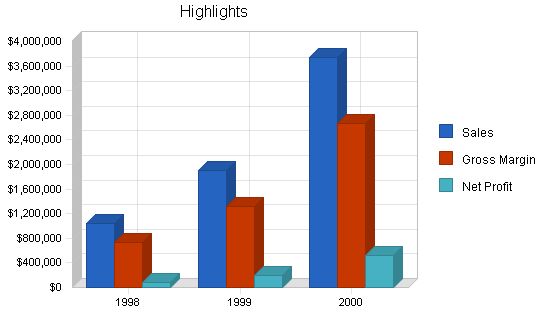
1.1 Objectives:
– Increase sales in 1999 and double sales in 2000.
– Increase gross margin and net profit margin.
– Maintain personnel at a ratio of 1 full-time person for every $250K in revenue.
– Maintain at least 30% market share of Product X according to PC Data.
1.2 Keys to Success:
– Marketing power: have products on shelves with attractive packaging and sufficient marketing power to maintain a 30% or higher market share according to PC Data.
– Product quality and customer satisfaction: all products guarantee promised functionality.
– Long-term customer satisfaction is critical.
– Strong management team with expertise in marketing, management, finance, and product development.
– Sufficient working capital to survive in the retail channel.
1.3 Mission:
Supple Software develops, publishes, and markets business tools and know-how in a software product, making them accessible to millions of users. The company generates profit and cash, offers a rewarding work environment and fair compensation to employees, a fair return to owners, and a fair royalty to authors.
Supple Software was founded in 1993 by Ralph Smith to market Product X software. It moved into its current space in 1996 and added new products, acquiring shelf space in retail.
2.1 Company Ownership:
Supple Software, Inc. is now a subchapter S Corporation owned by Ralph Smith and his wife Mabel. It became subchapter S in the 1996 tax year after previously being subchapter C. The fiscal year is the calendar year. The corporation was established with 100 shares, 51 owned by Ralph Smith and 49 owned by Mabel Smith.
2.2 Company History:
Supple Software, Inc. was originally founded in Ourtown in 1993 as Infoplan, a sole proprietorship. It was later incorporated in Delaware as Infoplan, Inc., and then in California as Supple Software, Inc. Infoplan, Inc. was dissolved.
For most of its existence, this was a one-man consulting company supporting a product company. It maintained a conservative approach to products and advertising, relying on published reviews and direct sales until the market expanded.
In 1995, a breakthrough product called Product X™ was introduced, featuring the first effective task X software with bundled spreadsheet and word processor capabilities and automatic charts.
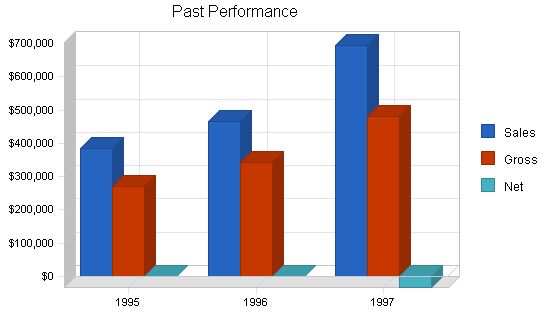
| 1995 | 1996 | 1997 | |
| $384,113 | $464,592 | $695,136 | |
| $270,062 | $342,824 | $480,163 | |
| 70.31% | 73.79% | 69.07% | |
| $251,471 | $290,145 | $513,144 | |
| 0 | 0 | 34 | |
| 7.00 | 6.00 | 6.00 | |
| Current Assets | |||
| Cash | $0 | $0 | $625 |
| Accounts Receivable | $0 | $0 | $124,056 |
| Inventory | $0 | $0 | $28,623 |
| Other Current Assets | $0 | $0 | $431 |
| Total Current Assets | $0 | $0 | $153,735 |
| Long-term Assets | |||
| Long-term Assets | $0 | $0 | $35,577 |
| Accumulated Depreciation | $0 | $0 | $24,247 |
| Total Long-term Assets | $0 | $0 | $11,330 |
| Total Assets | $0 | $0 | $165,065 |
| Current Liabilities | |||
| Accounts Payable | $0 | $0 | $36,557 |
| Current Borrowing | $0 | $0 | $22,336 |
| Other Current Liabilities (interest free) | $0 | $0 | $25,526 |
| Total Current Liabilities | $0 | $0 | $84,419 |
| Long-term Liabilities | $0 | $0 | $0 |
| Total Liabilities | $0 | $0 | $84,419 |
| Paid-in Capital | $0 | $0 | $76,960 |
| Retained Earnings | $0 | $0 | $36,668 |
| Earnings | $0 | $0 | ($32,982) |
| Total Capital | $0 | $0 | $80,646 |
| Total Capital and Liabilities | $0 | $0 | $165,065 |
| Payment Days | 0 | 0 | 30 |
| Sales on Credit | $0 | $0 | $660,379 |
| Receivables Turnover | 0.00 | 0.00 | 5.32 |
Contents
Company Locations and Facilities
The company is located in Ourtown at 100 Main Street. We moved to our current space in 1996 from a home office. We rent 750 square feet for $900 per month under a two-year contract with limited rent increases.
Products
Our products are prescriptive software that provide guidance and empowerment to users. Our flagship product, Product X, is a best-seller. We also offer Product Y for Windows.
Customers don’t purchase our products for the software itself, but for the benefits they provide and the solution they offer to a problem. They want reassurance that the job is done right and that they are prepared when presenting their plans. Our products have a strong reputation and we have sold over 70,000 units through various channels. We are listed in product databases and have a network of direct buyers and registered users.
Product Description
- Product X: Suggested Retail Price $XX, street price $XX. According to PC Data, it is the second-leading Windows task X software in the U.S. market and the quality leader. It features an easy-to-use, step-by-step interface with a powerful business analysis model and complete financial analysis.
- Product Y: Suggested Retail Price $XX, street price $XX. It is a stand-alone task Y application for Windows, offering more than just that with its complete [omitted]. It is considered the best product available for creating a task Y and managing the [omitted] function.
- Product Z: Suggested Retail Price $XX, street price $XX. It is a stand-alone task Y application for Windows, offering more than just that with its complete [omitted]. It is considered the best product available for creating a task Y and managing the [omitted] function.
Competitive Comparison
In addition to books, magazines, courses, seminars, and consultants, we compete against three other task X packages sold through retail: Product A by Competitor A, Product B by Competitor B, and Product C by Company C. Our main competitor, AAA, is privately owned and well financed. While they imitated our early template products, we maintain a competitive edge in terms of product quality and reviews. BBB, the third-place competitor, is fading, and CCC, the fourth-place competitor, has the potential to become a serious competitor as they expand their product line.
Sales Literature
Refer to the appendices for our sales literature and collaterals, which showcase our consistent packaging and advertising theme.
Sourcing
A detailed discussion of vendors has been omitted for brevity.
Technology
Both Product X and Product Y are enhancements of previous products copyrighted by Ralph Smith and Supple Software. We have a software development engine that brings together guided text, spreadsheet tables, and charts in a user-friendly environment with wizards, help files, and on-line coaching.
- This discussion has been omitted as it contains specific product and company information.
- This discussion has been omitted as it contains specific product and company information.
Future Products
Our future product development is primarily driven by market needs. We have a strong understanding of our target market segment and a core product engine that serves as the foundation for future products.
- Our next big product will [material omitted]. It will be compatible with both Product X and Product Y future versions, creating a true management system for small businesses. We have already developed an in-house system that could serve as the prototype.
- Our second major product development effort, pending further research on customer needs, might be the [omitted].
- We are also considering a new product [omitted].
Market Analysis Summary
Our market includes millions of people in home offices, small offices, business schools, and professional offices. The growing need for people to perform tasks X, Y, and Z favors our business.
According to research published last year, the [product area] market is worth an estimated $3.8 billion and projected to grow at 20% per year. The [industry] Association estimates total retail sales of $3.075 billion.
Market Segmentation
Our target customers are adults in small businesses, home offices, and academic institutions. They have a range of computer and business skills, but are relatively unsophisticated in computing and business management. They are looking for a do-it-yourself product that helps them get the job done without the need for experts. Additionally, consultants, accountants, and experts use our products to maximize productivity. Our products are also used by business schools and teachers for their teaching power.
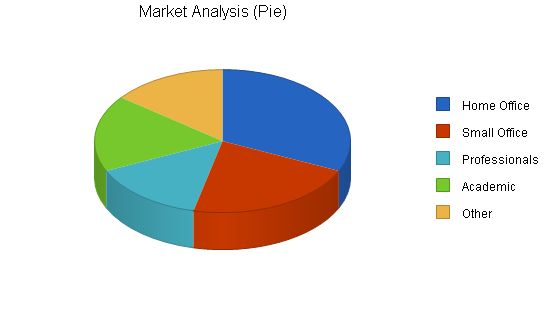
1998 1999 2000 2001 2002
——————————–
Potential Customers
Home Office 22,000 22,440 22,889 23,347 23,814
Small Office 15,000 15,750 16,538 17,365 18,233
Professionals 10,000 10,800 11,664 12,597 13,605
Academic 12,000 12,000 12,000 12,000 12,000
Other 10,000 10,000 10,000 10,000 10,000
Total 69,000 70,990 73,091 75,309 77,652
4.2 Target Market Segment Strategy
This should be a thoughtful discussion of why we have chosen our target markets. We compete in areas that lend themselves to local competition, product and channel areas that match our strengths, and avoid our weaknesses.
We operate only in the mainstream XXX and YYY channels, where we can compete with higher prices and better margins. We are positioned in the smaller stores and chains, where the customer base is sensitive to environment, ethics, and community, and in tune with our vision.
4.2.1 Market Growth
The market for non-U.S. personal computers has been growing approximately 22% per year during the last three years, according to a study by InfoQuest published in the Wall Street Journal. This level of growth presumably applies to related products as well and is higher than growth in the U.S. market.
The growth in specialty international marketing consulting is estimated at 40% per year, according to a report in the San Jose Chronicle.
In our market analysis, we suggest growth in the number of potential customers between 6% and 7% per year.
4.2.2 Market Trends
One important trend is the increase in international sales in personal computing products. All major manufacturers are recording more gains in the non-U.S. market than in the U.S. market.
Another trend is the greater use of specialized and focused consultants, instead of in-house resources. Companies are looking for more outsourcing and a preference for variable costs.
4.2.3 Market Needs
Our target SBs are dependent on reliable information technology. They use computers for a range of functions including accounting, shipping, inventory, communications, and personal productivity. They come to us for reliable service and support to substitute for their in-house people.
These businesses want reliable expertise and are not interested in shopping for rock-bottom prices. They value reliable providers.
Our standard SBs will be 5-20 unit installations, critically dependent on local-area networks. Back-up, training, installation, and ongoing support are important. They require database and administrative software as the core of their systems.
The software industry is frequently segmented according to product type. We prefer segmentation by economics and buying patterns:
1. OEM Software Development: software sold through others.
2. Mainline Packaged Software: software sold through direct sales to large buyers, direct response, catalogs, and retail stores.
3. Specialty or Vertical Market Software: sold outside the main software channels with careful target marketing.
Another segmentation divides the market by buyer/user types:
1. Consumer: users of home blippos.
2. Small Business: 10 million businesses in the United States.
3. Large Business: businesses with complex needs.
4.3.1 Competition and Buying Patterns
The most important factor in software is the bandwagon. Market share generates more market share. Brand names assure quality. Buyers are willing to pay high prices for solutions that work. Channels discount heavily. There is no consensus about software copying. Impulse buying goes on with products below $100. Distribution channels are clogged. Support becomes a serious factor at higher price levels.
4.3.2 Main Competitors
Supple Software Company distinguishes itself through specific business tasks.
The main competitors are sellers of cheap dealio software. Their strength is their price, but their weakness is their lack of usefulness and documentation.
4.3.3 Industry Participants
Supple Software Company is part of an immature industry with high growth rates, low barriers to entry, and many small competitors. Leaders in the industry have emerged and have revenues in the hundreds of millions of dollars annually.
The market for software is worth an estimated $3.8 billion and is projected to grow at 20% per year. The top 10 companies account for less than one third of the total market.
4.3.4 Distribution Patterns
Distribution channels are a bottleneck in the industry. Marketing costs are a barrier to entry. Brand names carry more weight. Developers often choose to work with major brands instead of marketing on their own. Royalties are low. There are exceptions to the rule.
Strategy and Implementation Summary
Our strategy is based on serving niche markets well. We focus on small and medium-sized businesses that can’t get good products or services from major vendors. We aim to reach specific types of businesses across the country.
5.1 Strategy Pyramid
Our main strategy is to position ourselves at the top of the quality scale, offering superb technology and fine programming to buyers who want the best quality. Our tactics include research and development, choosing the right distribution channels, and communicating our quality position.
Supple Software offers the discriminating personal computer user a combination of the highest quality software and latest technology, at a fair price.
5.3 Competitive Edge
Our competitive edge is our software engine, knowledge of the product area, and commitment to customer satisfaction.
Our marketing strategy emphasizes focus. We focus on certain kinds of products and users. We focus on product quality, reviews, consistent branding, and key media.
5.4.1 Pricing Strategy
Our pricing is determined by our focus on retail sales. We aim for prices in the high two-digits, which are acceptable to customers.
5.4.2 Promotion Strategy
Our advertising, co-promotion efforts, and PR are key parts of our promotion strategy. We focus on certain media and strong packaging.
5.4.3 Distribution Strategy
We concentrate our marketing efforts on the mainstream XXX and YYY channels. We leverage display advertising and look for interesting opportunities.
5.4.4 Marketing Programs
Our most important marketing program is focused on specific objectives that should be measured by concrete metrics. We have another key marketing program that focuses on different objectives.
5.4.5 Positioning Statement
For business owners and managers who need to deal with Task X, Product X is software that creates and helps manage professional Task X. For small businesses, professionals, and the self-employed who recognize the importance of managing cash flow, Product X is financial software that handles all essential bookkeeping functions.
5.5 Sales Strategy
Our sales strategy focuses on retail sales and point of purchase decisions. Our marketing aims to create knowledge and awareness of the product category.
5.5.1 Sales Forecast
Our sales forecast for 1998 is based on estimated unit sales for Product X and Product Y. We expect Product X to sell 15,000 units and Product Y to sell 3,000 units.
The Monthly Sales Chart shows some seasonality in our business.
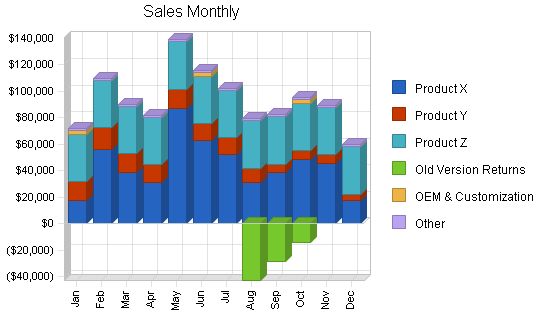
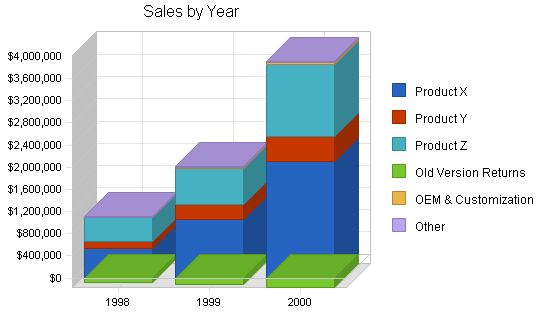
Sales Forecast
(Unit Sales)
Product X
1998: 15,100
1999: 30,000
2000: 60,000
Product Y
1998: 2,976
1999: 6,000
2000: 10,000
Product Z
1998: 1,320
1999: 2,000
2000: 4,000
Old Version Returns
1998: -900
1999: -1,200
2000: -1,800
OEM & Customization
1998: 9
1999: 25
2000: 35
Other
1998: 12
1999: 15
2000: 20
Total Unit Sales
1998: 18,517
1999: 36,840
2000: 72,255
(Unit Prices)
Product X
1998: $35.00
Product Y
1998: $45.00
Product Z
1998: $325.00
Old Version Returns
1998: $95.00
OEM & Customization
1998: $1,000.00
Other
1998: $1,500.00
(Sales)
Product X
1998: $528,500
1999: $1,050,000
2000: $2,100,000
Product Y
1998: $133,920
1999: $270,000
2000: $450,000
Product Z
1998: $429,000
1999: $650,000
2000: $1,300,000
Old Version Returns
1998: ($85,500)
1999: ($114,000)
2000: ($171,000)
OEM & Customization
1998: $9,000
1999: $25,000
2000: $35,000
Other
1998: $18,000
1999: $22,500
2000: $30,000
Total Sales
1998: $1,032,920
1999: $1,903,500
2000: $3,744,000
(Direct Unit Costs)
Product X
1998: $7.82
1999: $8.50
2000: $8.00
Product Y
1998: $8.39
Product Z
1998: $0.00
Old Version Returns
1998: $0.00
OEM & Customization
1998: $0.00
Other
1998: $0.00
1999: $8.50
2000: $8.00
(Direct Cost of Sales)
Product X
1998: $118,082
1999: $255,000
2000: $480,000
Product Y
1998: $24,969
1999: $50,340
2000: $83,900
Product Z
1998: $0
1999: $0
2000: $0
Old Version Returns
1998: $0
1999: $0
2000: $0
OEM & Customization
1998: $0
1999: $0
2000: $0
Other
1998: $0
1999: $128
2000: $160
Sales Programs
– We work with [omitted] (XXX) to develop and consolidate our retail channel sales. XXX is a national sales rep firm operating in Ourtown. It has an office in Southern California, a rep in Canada, and good relations with our major distributors. XXX receives a 6% commission on sales to major distributors.
– We have tasked XXX with four key objectives for 1998: increase sell-through numbers, improve shelf stocking levels, gain entry into XXX, and secure representation in XXX. As of April, we have achieved entry into XXX and improved stocking levels. However, we are still working on gaining representation in XXX and achieving optimal sell-through.
– We aim to strengthen our relationship with XXX, the second-largest provider of personal computer software to retail channels.
Strategic Alliances
Product development: Our main focus is on developing and launching new versions of Product X and Product Y.
Marketing: We need to closely monitor sell-through and performance to evaluate the results of our 1997 marketing efforts. Initial sales reviews indicate a successful launch, but ongoing monitoring is necessary.
Finance: We are also working on enhancing our capital structure and management team.
Milestones
The milestones table and chart provide detailed information about program activities planned for the year. Each activity has its manager, start date, end date, and budget. We will track implementation against the plan and provide reports on timely completion.
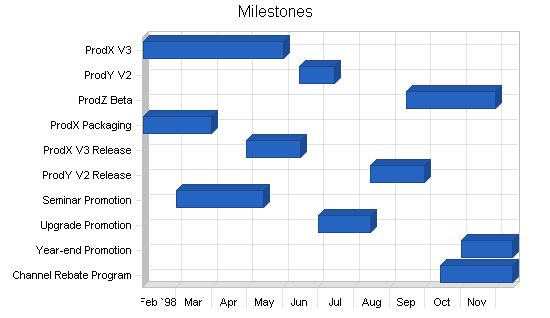
Milestones:
ProdX V3: 2/1/1998 – 6/1/1998, $5,000, ABC, Department
ProdY V2: 6/15/1998 – 7/15/1998, $15,000, ABC, Department
ProdZ Beta: 9/15/1998 – 11/30/1998, $10,000, ABC, Department
ProdX Packaging: 2/1/1998 – 3/31/1998, $15,000, ABC, Department
ProdX V3 Release: 4/30/1998 – 6/16/1998, $10,000, ABC, Department
ProdY V2 Release: 8/15/1998 – 9/30/1998, $5,000, ABC, Department
Seminar Promotion: 3/1/1998 – 5/15/1998, $10,000, ABC, Department
Upgrade Promotion: 7/1/1998 – 8/15/1998, $50,000, ABC, Department
Year-end Promotion: 11/1/1998 – 12/15/1998, $25,000, ABC, Department
Channel Rebate Program: 10/14/1998 – 12/15/1998, $5,000, ABC, Department
Totals: $150,000
Management Summary
We are a small company owned and operated by Ralph and Mabel Smith, husband and wife, as a Subchapter S corporation. Ralph is the developer and designer of the products, and Mabel manages the office.
Management style reflects the participation of the owners. The company respects its community of co-workers and treats all workers well. We attempt to develop and nurture the company as community. We are not very hierarchical.
6.1 Organizational Structure
Ralph Smith, President, is responsible for overall business management. Our managers of finance, marketing, and sales report directly to Ralph.
Jim Graham, programmer, is responsible for product design and development.
As co-owners, Ralph and Mabel jointly develop business strategy and long-term plans. Ralph is strong on product know-how and technology, and Mabel is strong on management and business know-how.
6.2 Management Team
-Ralph Smith: President and founder. Smith worked for 10 years in sales and marketing with Arrog International before returning to California to found what has become Supple Software. He was sales manager of the eastern region when he founded the original software distribution company. MBA from Stanford, MA with honors from University of Oregon, BA magna cum laude from the University of Notre Dame. Forty years old, married, five children.
-Allen Lombard: on board of directors. ______, _________. Previously General Manager for ________, where sales increased during his 1982-1987 management from less than $3 million to $29 million annually. MBA Harvard Business School, BS Stanford.
-Mabel Smith: Consultant, general manager. Was the manager of XYZ Lumber in Standard before being hired by Acme six years ago. BA in Business Administration, University of North Carolina.
-Henry Callahan: on board of directors. Well-known and respected public relations and advertising consultant based in Blank.
-Perry Masonjar: attorney and secretary of board. Founding attorney of _____, _________, Austec, and other start-ups.
-Linda Wilson: Marketing Coordinator. 25 years old. BA Marketing, _____________.
6.3 Management Team Gaps
-The present team is very weak on professional sales.
-The present team, though strong on how to market at a high level, is short on practical front-line marketing experience.
-Product development requires a stable of entrepreneurial inventors willing to work for royalties.
6.4 Personnel Plan
Our people are compensated well, for the Ourtown market. Compensation includes complete HMO health care for the employee and all dependents, a dental plan, a 401K with generous profit sharing, and two weeks of vacations. The atmosphere at work is enhanced by teambuilding activities including river rafting, roller skating, pizza parties, etc.
We do expect to increase personnel significantly as sales increase.
Monthly personnel details for 1998 are in the appendix.
Personnel Plan
1998 1999 2000
Production Personnel
Technical Support Manager $33,300 $37,000 $41,000
Technical Support Staff $0 $25,000 $50,000
Other $0 $0 $0
Subtotal $33,300 $62,000 $91,000
Sales and Marketing Personnel
Marketing Manager $48,000 $53,000 $58,000
Other $0 $0 $0
Subtotal $48,000 $53,000 $58,000
General and Administrative Personnel
President $60,000 $66,000 $73,000
Office Manager $30,000 $33,000 $36,000
Other $0 $0 $0
Subtotal $90,000 $99,000 $109,000
Other Personnel
Development $30,300 $50,000 $100,000
Other $0 $0 $0
Subtotal $30,300 $50,000 $100,000
Total People 5 7 8
Total Payroll $201,600 $264,000 $358,000
Ideally, we would want to bring in some equity investment from investors compatible with our growth plan, management style, and vision, in return for some equity ownership. We are not going to talk about specifics of a deal until we have met the right partners. This plan does not call for equity from outside investors.
If and when the time for outside investors comes, we want compatible investors or no investors at all. Compatibility means:
1. A fundamental respect for giving our customers value, and for maintaining a healthy and happy workplace.
2. Respect for realistic forecasts, and conservative cash flow and financial management.
3. Cash flow as first priority, growth second, profits third.
4. Located in Oregon or the Northwest.
5. Willingness to follow the company carefully and contribute valuable input to strategy and implementation decisions.
Of these, only the last two are flexible.
We want to establish a mechanism for employees to acquire fair stock options that can become valuable as the company grows.
7.1 Important Assumptions
The financial plan depends on important assumptions, most of which are shown in the following table. The key underlying assumptions are:
-We assume a slow-growth economy, without major recession.
-We assume of course that there are no unforeseen changes in technology to make products immediately obsolete.
-We assume access to equity capital and financing sufficient to maintain our financial plan as shown in the tables.
7.2 Key Financial Indicators
The following chart shows changes in key financial indicators: sales, gross margin, operating expenses, collection days, and inventory turnover. The growth in sales is the most obvious change, and operating expenses with sales. We believe the growing market for our products, the larger potential market, justifies the growth projections.
We expect to maintain gross margin at a high level without major changes.
The projections for collection days and inventory turnover show that we are already expecting improvements as our increasing sales gives us greater economies of scale, and greater negotiation strength with our channel partners.
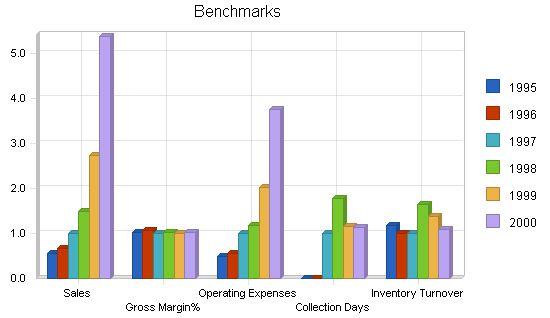
The table below outlines our projected profit and loss for the next three years. We aim to maintain our gross margin while increasing our net profit margin. The main factor contributing to this improvement is the economies of scale in our general and administrative expenses, which should decrease as a percentage of sales from 1998 to 2000.
However, we anticipate that sales and marketing expenses will remain unchanged as a percentage of sales. The nature of the packaged software business requires substantial marketing expenses.
Additionally, we plan to allocate a higher percentage of revenue towards development. By 2000, we anticipate spending approximately 7% of sales on product development. This investment is crucial to our future success.
Please note that the following table displays the annual figures only. The appendix contains more detailed monthly projections for 1988.
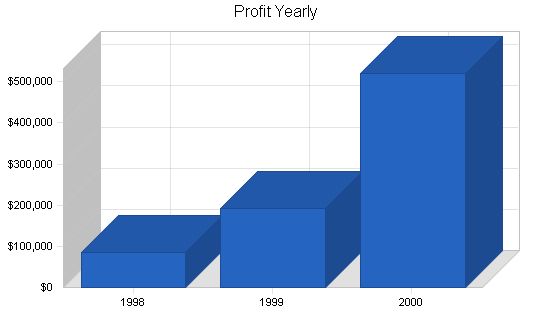
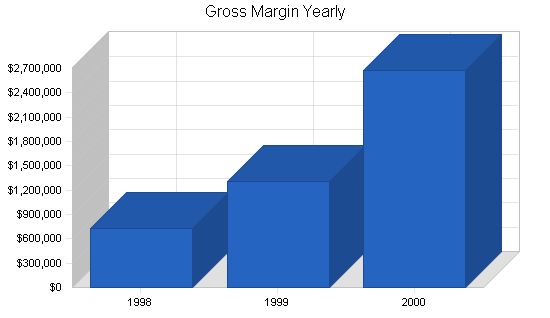
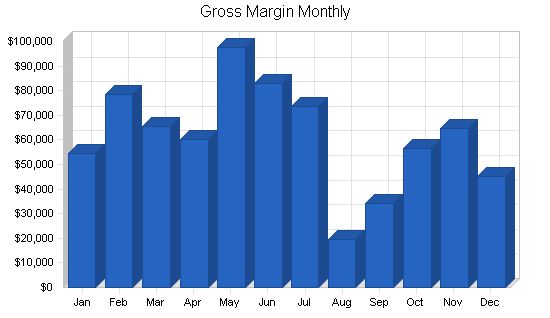
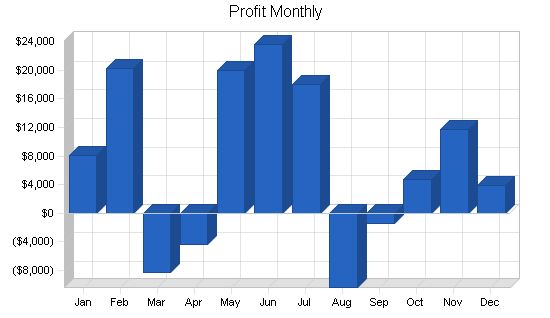
Pro Forma Profit and Loss
1998 | 1999 | 2000
Sales | $1,032,920 | $1,903,500 | $3,744,000
Direct Cost of Sales | $143,051 | $305,468 | $564,060
Production Payroll | $33,300 | $62,000 | $91,000
Freight | $20,546 | $29,000 | $33,800
Royalties | $103,298 | $197,550 | $385,200
Total Cost of Sales | $300,195 | $594,018 | $1,074,060
Gross Margin | $732,725 | $1,309,483 | $2,669,940
Gross Margin% | 70.94% | 68.79% | 71.31%
Operating Expenses
Sales and Marketing Expenses
Sales and Marketing Payroll | $48,000 | $53,000 | $58,000
Advertising/Promotion | $210,000 | $400,000 | $770,000
Sales Commissions | $61,981 | $118,530 | $231,120
Graphics and Collaterals | $35,000 | $70,000 | $140,000
Printing | $28,700 | $57,000 | $114,000
Public Relations | $14,400 | $29,000 | $58,000
Research | $2,000 | $4,000 | $8,000
Tollfree Telephone | $6,000 | $12,000 | $24,000
Trade Shows and Events | $6,000 | $12,000 | $24,000
Meals | $4,300 | $9,000 | $18,000
Travel | $12,800 | $26,000 | $52,000
Other Sales and Marketing Expenses | $12,000 | $24,000 | $48,000
Total Sales and Marketing Expenses | $441,181 | $814,530 | $1,545,120
Sales and Marketing% | 42.71% | 42.79% | 41.27%
General and Administrative Expenses
General and Administrative Payroll | $90,000 | $99,000 | $109,000
Marketing/Promotion | $0 | $0 | $0
Depreciation | $1,000 | $1,250 | $1,563
Online Services | $3,600 | $4,500 | $5,625
Contributions | $300 | $375 | $469
Dues and Subscriptions | $600 | $750 | $938
Maintenance and Repairs | $1,800 | $2,250 | $2,813
Office Supplies | $1,200 | $1,500 | $1,875
Postage | $2,400 | $3,000 | $3,750
Professional Fees | $6,000 | $7,500 | $9,375
Telephone | $9,000 | $11,250 | $14,063
Rent | $10,800 | $13,500 | $16,875
Utilities | $3,000 | $3,750 | $4,688
Insurance | $6,000 | $7,500 | $9,375
Payroll Taxes | $0 | $0 | $0
Other General and Administrative Expenses | $0 | $0 | $0
Total General and Administrative Expenses | $135,700 | $156,125 | $180,409
General and Administrative% | 13.14% | 8.20% | 4.82%
Other Expenses
Other Payroll | $30,300 | $50,000 | $100,000
Consultants | $0 | $0 | $0
Product Development | $1,200 | $15,000 | $100,000
Total Other Expenses | $31,500 | $65,000 | $200,000
Other% | 3.05% | 3.41% | 5.34%
Total Operating Expenses | $608,381 | $1,035,655 | $1,925,529
Profit Before Interest and Taxes | $124,344 | $273,828 | $744,411
EBITDA | $125,344 | $275,078 | $745,974
Interest Expense | $1,734 | $234 | $234
Taxes Incurred | $36,783 | $82,078 | $223,253
Net Profit | $85,828 | $191,516 | $520,924
Net Profit/Sales | 8.31% | 10.06% | 13.91%
7.4 Break-even Analysis
Our break-even analysis is based on our current cost and price structure. As we grow, fixed costs will increase in proportion to our employee numbers.
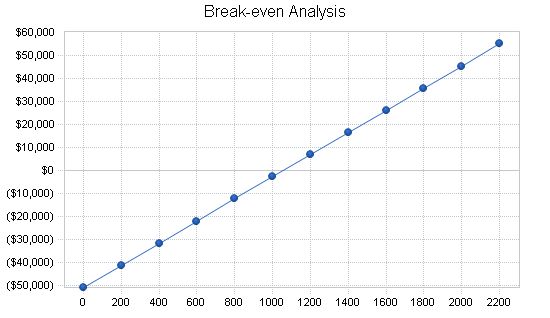
Break-even Analysis:
Monthly Units Break-even: 1,055
Monthly Revenue Break-even: $58,848
Assumptions:
Average Per-Unit Revenue: $55.78
Average Per-Unit Variable Cost: $7.73
Estimated Monthly Fixed Cost: $50,698
7.5 Projected Cash Flow:
The following chart illustrates our cash projections for the next 12 months. Due to our reliance on sales through channels and their tendency to pay slowly, we need working capital from short-term credit on receivables and inventory to support wide variations.
The table only shows annual results, which are less significant. The monthly cash flow table in the appendix is the key to our business plan and represents the key numbers in the following chart.
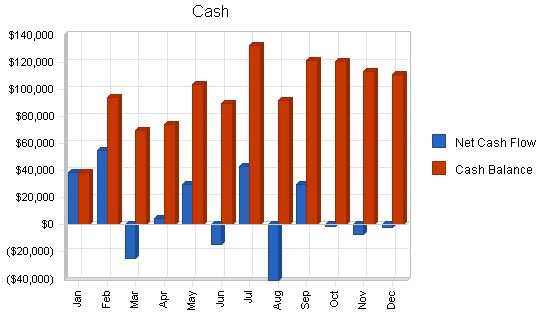
Pro Forma Cash Flow
[table]
[tr][td]Year[/td][td]Cash Received[/td][/tr]
[tr][td]1998[/td][td]$1,114,316[/td][/tr]
[tr][td]1999[/td][td]$1,829,645[/td][/tr]
[tr][td]2000[/td][td]$3,587,863[/td][/tr][/table]
7.6 Projected Balance Sheet
The table shows the annual balance sheet results, with a projected increase in net worth.
[table]
[tr][td]Year[/td][td]Assets[/td][/tr]
[tr][td]1998[/td][td]$216,988[/td][/tr]
[tr][td]1999[/td][td]$500,089[/td][/tr]
[tr][td]2000[/td][td]$1,135,896[/td][/tr][/table]
7.7 Business Ratios
Standard business ratios are included in the following table. The ratios show balanced, healthy growth.
[table]
[tr][td]Year[/td][td]Sales Growth[/td][/tr]
[tr][td]1998[/td][td]48.59%[/td][/tr]
[tr][td]1999[/td][td]84.28%[/td][/tr]
[tr][td]2000[/td][td]96.69%[/td][/tr][/table]
Note: Detailed monthly projections, additional ratios, and other information can be found in the appendix.
Sales Forecast
Unit Sales
Product X: 0%, Jan: 500, Feb: 1,600, Mar: 1,100, Apr: 900, May: 2,500, Jun: 1,800, Jul: 1,500, Aug: 900, Sep: 1,100, Oct: 1,400, Nov: 1,300, Dec: 500
Product Y: 0%, Jan: 325, Feb: 365, Mar: 325, Apr: 295, May: 315, Jun: 285, Jul: 285, Aug: 235, Sep: 145, Oct: 145, Nov: 145, Dec: 111
Product Z: 0%, Jan: 110, Feb: 110, Mar: 110, Apr: 110, May: 110, Jun: 110, Jul: 110, Aug: 110, Sep: 110, Oct: 110, Nov: 110, Dec: 110
Old Version Returns: 0%, Jan: 0, Feb: 0, Mar: 0, Apr: 0, May: 0, Jun: 0, Jul: 0, Aug: -450, Sep: -300, Oct: -150, Nov: 0, Dec: 0
OEM & Customization: 0%, Jan: 3, Feb: 0, Mar: 0, Apr: 0, May: 0, Jun: 3, Jul: 0, Aug: 0, Sep: 0, Oct: 3, Nov: 0, Dec: 0
Other: 0%, Jan: 1, Feb: 1, Mar: 1, Apr: 1, May: 1, Jun: 1, Jul: 1, Aug: 1, Sep: 1, Oct: 1, Nov: 1, Dec: 1
Total Unit Sales: Jan: 939, Feb: 2,076, Mar: 1,536, Apr: 1,306, May: 2,926, Jun: 2,199, Jul: 1,896, Aug: 796, Sep: 1,056, Oct: 1,509, Nov: 1,556, Dec: 722
Unit Prices
Product X: Jan-Dec: $35.00
Product Y: Jan-Dec: $45.00
Product Z: Jan-Dec: $325.00
Old Version Returns: Jan-Dec: $95.00
OEM & Customization: Jan-Dec: $1,000.00
Other: Jan-Dec: $1,500.00
Sales
Product X: Jan: $17,500, Feb: $56,000, Mar: $38,500, Apr: $31,500, May: $87,500, Jun: $63,000, Jul: $52,500, Aug: $31,500, Sep: $38,500, Oct: $49,000, Nov: $45,500, Dec: $17,500
Product Y: Jan: $14,625, Feb: $16,425, Mar: $14,625, Apr: $13,275, May: $14,175, Jun: $12,825, Jul: $12,825, Aug: $10,575, Sep: $6,525, Oct: $6,525, Nov: $6,525, Dec: $4,995
Product Z: Jan: $35,750, Feb: $35,750, Mar: $35,750, Apr: $35,750, May: $35,750, Jun: $35,750, Jul: $35,750, Aug: $35,750, Sep: $35,750, Oct: $35,750, Nov: $35,750, Dec: $35,750
Old Version Returns: Jan: $0, Feb: $0, Mar: $0, Apr: $0, May: $0, Jun: $0, Jul: $0, Aug: ($42,750), Sep: ($28,500), Oct: ($14,250), Nov: $0, Dec: $0
OEM & Customization: Jan: $3,000, Feb: $0, Mar: $0, Apr: $0, May: $0, Jun: $3,000, Jul: $0, Aug: $0, Sep: $0, Oct: $3,000, Nov: $0, Dec: $0
Other: Jan: $1,500, Feb: $1,500, Mar: $1,500, Apr: $1,500, May: $1,500, Jun: $1,500, Jul: $1,500, Aug: $1,500, Sep: $1,500, Oct: $1,500, Nov: $1,500, Dec: $1,500
Total Sales: Jan: $72,375, Feb: $109,675, Mar: $90,375, Apr: $82,025, May: $138,925, Jun: $116,075, Jul: $102,575, Aug: $36,575, Sep: $53,775, Oct: $81,525, Nov: $89,275, Dec: $59,745
Personnel Plan
Production Personnel
Technical Support Manager: Jan-Dec: $2,775
Technical Support Staff: Jan-Dec: $0
Other: Jan-Dec: $0
Subtotal: Jan-Dec: $2,775
Sales and Marketing Personnel
Marketing Manager: Jan-Dec: $4,000
Other: Jan-Dec: $0
Subtotal: Jan-Dec: $4,000
General and Administrative Personnel
President: Jan-Dec: $5,000
Office Manager: Jan-Dec: $2,500
Other: Jan-Dec: $0
Subtotal: Jan-Dec: $7,500
Other Personnel
Development: Jan-Dec: $2,525
Other: Jan-Dec: $0
Subtotal: Jan-Dec: $2,525
Total People: Jan-Dec: 5
Total Payroll: Jan-Dec: $16,800
Pro Forma Profit and Loss:
Jan Feb Mar Apr May Jun Jul Aug Sep Oct Nov Dec
Sales $72,375 $109,675 $90,375 $82,025 $138,925 $116,075 $102,575 $36,575 $53,775 $81,525 $89,275 $59,745
Direct Cost of Sales $6,637 $15,574 $11,329 $9,513 $22,193 $16,467 $14,121 $9,010 $9,819 $12,165 $11,383 $4,841
Production Payroll $2,775 $2,775 $2,775 $2,775 $2,775 $2,775 $2,775 $2,775 $2,775 $2,775 $2,775 $2,775
Freight $1,201 $2,056 $1,651 $1,479 $2,694 $2,146 $1,921 $1,434 $1,516 $1,741 $1,666 $1,041
Royalties 10% $7,238 $10,968 $9,038 $8,203 $13,893 $11,608 $10,258 $3,658 $5,378 $8,153 $8,928 $5,975
Total Cost of Sales $17,851 $31,373 $24,793 $21,970 $41,555 $32,996 $29,075 $16,877 $19,488 $24,834 $24,752 $14,632
Gross Margin $54,524 $78,302 $65,582 $60,055 $97,370 $83,079 $73,500 $19,698 $34,287 $56,691 $64,523 $45,113
Gross Margin % 75.34% 71.39% 72.57% 73.22% 70.09% 71.57% 71.65% 53.86% 63.76% 69.54% 72.27% 75.51%
Operating Expenses:
Sales and Marketing Expenses:
Sales and Marketing Payroll $4,000 $4,000 $4,000 $4,000 $4,000 $4,000 $4,000 $4,000 $4,000 $4,000 $4,000 $4,000
Advertising/Promotion $10,000 $20,000 $20,000 $20,000 $30,000 $20,000 $20,000 $10,000 $10,000 $20,000 $20,000 $10,000
Sales Commissions 6% $4,343 $6,581 $5,423 $4,922 $8,336 $6,965 $6,155 $2,195 $3,227 $4,892 $5,357 $3,585
Graphics and Collaterals $1,000 $1,000 $30,000 $2,000 $0 $0 $0 $500 $0 $0 $500 $0
Printing $2,200 $500 $500 $18,000 $5,000 $0 $0 $500 $500 $500 $500 $500
Public Relations $1,200 $1,200 $1,200 $1,200 $1,200 $1,200 $1,200 $1,200 $1,200 $1,200 $1,200 $1,200
Research $0 $0 $0 $0 $0 $0 $0 $0 $0 $0 $0 $2,000
Tollfree Telephone $500 $500 $500 $500 $500 $500 $500 $500 $500 $500 $500 $500
Trade Shows and Events $2,000 $0 $0 $0 $2,000 $0 $0 $0 $0 $2,000 $0 $0
Meals $650 $250 $250 $250 $750 $450 $250 $250 $250 $250 $450 $250
Travel $2,000 $400 $400 $400 $2,000 $1,000 $500 $500 $1,700 $1,700 $500 $1,700
Other Sales and Marketing Expenses $1,000 $1,000 $1,000 $1,000 $1,000 $1,000 $1,000 $1,000 $1,000 $1,000 $1,000 $1,000
Total Sales and Marketing Expenses $28,893 $35,431 $63,273 $52,272 $54,786 $35,115 $33,605 $20,645 $22,377 $36,042 $34,007 $24,735
Sales and Marketing % 39.92% 32.31% 70.01% 63.73% 39.44% 30.25% 32.76% 56.45% 41.61% 44.21% 38.09% 41.40%
General and Administrative Expenses:
General and Administrative Payroll $7,500 $7,500 $7,500 $7,500 $7,500 $7,500 $7,500 $7,500 $7,500 $7,500 $7,500 $7,500
Marketing/Promotion $0 $0 $0 $0 $0 $0 $0 $0 $0 $0 $0 $0
Depreciation $0 $0 $0 $0 $0 $0 $0 $0 $0 $0 $0 $1,000
Online Services $300 $300 $300 $300 $300 $300 $300 $300 $300 $300 $300 $300
Contributions $25 $25 $25 $25 $25 $25 $25 $25 $25 $25 $25 $25
Dues and Subscriptions $50 $50 $50 $50 $50 $50 $50 $50 $50 $50 $50 $50
Maintenance and Repairs $150 $150 $150 $150 $150 $150 $150 $150 $150 $150 $150 $150
Office Supplies $100 $100 $100 $100 $100 $100 $100 $100 $100 $100 $100 $100
Postage $200 $200 $200 $200 $200 $200 $200 $200 $200 $200 $200 $200
Pro Forma Cash Flow
Cash Received
Jan Feb Mar Apr May Jun Jul Aug Sep Oct Nov Dec
Cash Sales
$28,950 $43,870 $36,150 $32,810 $55,570 $46,430 $41,030 $14,630 $21,510 $32,610 $35,710 $23,898
Cash from Receivables
$62,028 $63,476 $44,171 $65,419 $54,058 $50,353 $82,898 $69,375 $60,225 $22,289 $32,820 $49,070
Subtotal Cash from Operations
$90,978 $107,346 $80,321 $98,229 $109,628 $96,783 $123,928 $84,005 $81,735 $54,899 $68,530 $72,968
Additional Cash Received
Sales Tax, VAT, HST/GST Received
0.00% $0 $0 $0 $0 $0 $0 $0 $0 $0 $0 $0 $0
New Current Borrowing
$0 $0 $0 $0 $0 $20,000 $0 $0 $0 $0 $0 $0 $0
New Other Liabilities (interest-free)
$2,132 $6,313 $0 $0 $6,146 $0 $5,546 $0 $0 $866 $3,327 $636
New Long-term Liabilities
$0 $0 $0 $0 $0 $0 $0 $0 $0 $0 $0 $0 $0
Sales of Other Current Assets
$0 $0 $0 $0 $0 $0 $0 $0 $0 $0 $0 $0 $0
Sales of Long-term Assets
$0 $0 $0 $0 $0 $0 $0 $0 $0 $0 $0 $0 $0
New Investment Received
$0 $0 $0 $0 $0 $0 $0 $0 $0 $0 $0 $0 $0
Subtotal Cash Received
$93,110 $113,659 $80,321 $98,229 $115,774 $116,783 $129,474 $84,005 $81,735 $55,765 $71,857 $73,604
Expenditures
Jan Feb Mar Apr May Jun Jul Aug Sep Oct Nov Dec
Expenditures from Operations
Cash Spending
$16,800 $16,800 $16,800 $16,800 $16,800 $16,800 $16,800 $16,800 $16,800 $16,800 $16,800 $16,800
Bill Payments
$37,918 $41,722 $68,146 $76,797 $69,221 $114,531 $69,206 $63,854 $25,014 $40,014 $62,473 $59,071
Subtotal Spent on Operations
$54,718 $58,522 $84,946 $93,597 $86,021 $131,331 $86,006 $80,654 $41,814 $56,814 $79,273 $75,871
Additional Cash Spent
Sales Tax, VAT, HST/GST Paid Out
$0 $0 $0 $0 $0 $0 $0 $0 $0 $0 $0 $0 $0
Principal Repayment of Current Borrowing
$0 $0 $0 $0 $0 $0 $0 $40,000 $0 $0 $0 $0 $0
Other Liabilities Principal Repayment
$0 $0 $20,000 $0 $0 $0 $0 $4,453 $10,000 $0 $0 $0 $0
Long-term Liabilities Principal Repayment
$0 $0 $0 $0 $0 $0 $0 $0 $0 $0 $0 $0 $0
Purchase Other Current Assets
$0 $0 $0 $0 $0
Hello!
I’m Andrew Brooks, a seasoned finance consultant from the USA and the mind behind phonenumber247.com.
My career is built on a foundation of helping individuals and businesses thrive financially in an ever-changing economic landscape. At phonenumber247.com, my aim is to demystify the complex world of finance, providing clear, actionable advice that can help you navigate your financial journey with confidence. Whether it’s personal finance management, investment strategies, or understanding the nuances of market dynamics, I’m here to share insights and tools that can propel you towards your financial goals.
Welcome to my digital space, where every piece of advice is a step closer to financial clarity and success!
